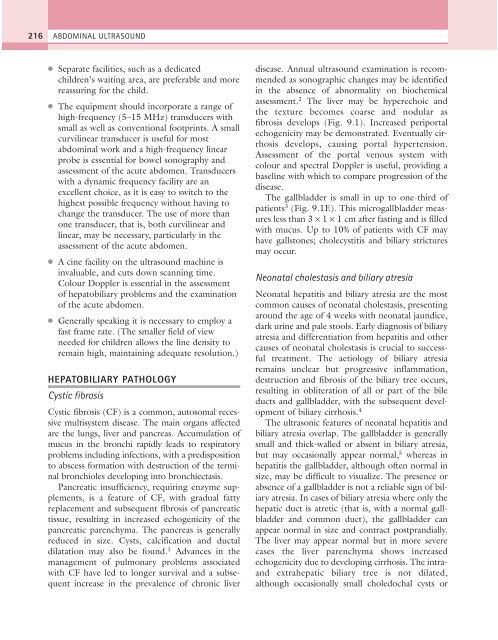9%20ECOGRAFIA%20ABDOMINAL%20COMO%20CUANDO%20DONDE
Create successful ePaper yourself
Turn your PDF publications into a flip-book with our unique Google optimized e-Paper software.
216<br />
ABDOMINAL ULTRASOUND<br />
●<br />
●<br />
●<br />
●<br />
Separate facilities, such as a dedicated<br />
children’s waiting area, are preferable and more<br />
reassuring for the child.<br />
The equipment should incorporate a range of<br />
high-frequency (5–15 MHz) transducers with<br />
small as well as conventional footprints. A small<br />
curvilinear transducer is useful for most<br />
abdominal work and a high-frequency linear<br />
probe is essential for bowel sonography and<br />
assessment of the acute abdomen. Transducers<br />
with a dynamic frequency facility are an<br />
excellent choice, as it is easy to switch to the<br />
highest possible frequency without having to<br />
change the transducer. The use of more than<br />
one transducer, that is, both curvilinear and<br />
linear, may be necessary, particularly in the<br />
assessment of the acute abdomen.<br />
A cine facility on the ultrasound machine is<br />
invaluable, and cuts down scanning time.<br />
Colour Doppler is essential in the assessment<br />
of hepatobiliary problems and the examination<br />
of the acute abdomen.<br />
Generally speaking it is necessary to employ a<br />
fast frame rate. (The smaller field of view<br />
needed for children allows the line density to<br />
remain high, maintaining adequate resolution.)<br />
HEPATOBILIARY PATHOLOGY<br />
Cystic fibrosis<br />
Cystic fibrosis (CF) is a common, autosomal recessive<br />
multisystem disease. The main organs affected<br />
are the lungs, liver and pancreas. Accumulation of<br />
mucus in the bronchi rapidly leads to respiratory<br />
problems including infections, with a predisposition<br />
to abscess formation with destruction of the terminal<br />
bronchioles developing into bronchiectasis.<br />
Pancreatic insufficiency, requiring enzyme supplements,<br />
is a feature of CF, with gradual fatty<br />
replacement and subsequent fibrosis of pancreatic<br />
tissue, resulting in increased echogenicity of the<br />
pancreatic parenchyma. The pancreas is generally<br />
reduced in size. Cysts, calcification and ductal<br />
dilatation may also be found. 1 Advances in the<br />
management of pulmonary problems associated<br />
with CF have led to longer survival and a subsequent<br />
increase in the prevalence of chronic liver<br />
disease. Annual ultrasound examination is recommended<br />
as sonographic changes may be identified<br />
in the absence of abnormality on biochemical<br />
assessment. 2 The liver may be hyperechoic and<br />
the texture becomes coarse and nodular as<br />
fibrosis develops (Fig. 9.1). Increased periportal<br />
echogenicity may be demonstrated. Eventually cirrhosis<br />
develops, causing portal hypertension.<br />
Assessment of the portal venous system with<br />
colour and spectral Doppler is useful, providing a<br />
baseline with which to compare progression of the<br />
disease.<br />
The gallbladder is small in up to one-third of<br />
patients 3 (Fig. 9.1E). This microgallbladder measures<br />
less than 3 × 1 × 1 cm after fasting and is filled<br />
with mucus. Up to 10% of patients with CF may<br />
have gallstones; cholecystitis and biliary strictures<br />
may occur.<br />
Neonatal cholestasis and biliary atresia<br />
Neonatal hepatitis and biliary atresia are the most<br />
common causes of neonatal cholestasis, presenting<br />
around the age of 4 weeks with neonatal jaundice,<br />
dark urine and pale stools. Early diagnosis of biliary<br />
atresia and differentiation from hepatitis and other<br />
causes of neonatal cholestasis is crucial to successful<br />
treatment. The aetiology of biliary atresia<br />
remains unclear but progressive inflammation,<br />
destruction and fibrosis of the biliary tree occurs,<br />
resulting in obliteration of all or part of the bile<br />
ducts and gallbladder, with the subsequent development<br />
of biliary cirrhosis. 4<br />
The ultrasonic features of neonatal hepatitis and<br />
biliary atresia overlap. The gallbladder is generally<br />
small and thick-walled or absent in biliary atresia,<br />
but may occasionally appear normal, 5 whereas in<br />
hepatitis the gallbladder, although often normal in<br />
size, may be difficult to visualize. The presence or<br />
absence of a gallbladder is not a reliable sign of biliary<br />
atresia. In cases of biliary atresia where only the<br />
hepatic duct is atretic (that is, with a normal gallbladder<br />
and common duct), the gallbladder can<br />
appear normal in size and contract postprandially.<br />
The liver may appear normal but in more severe<br />
cases the liver parenchyma shows increased<br />
echogenicity due to developing cirrhosis. The intraand<br />
extrahepatic biliary tree is not dilated,<br />
although occasionally small choledochal cysts or



